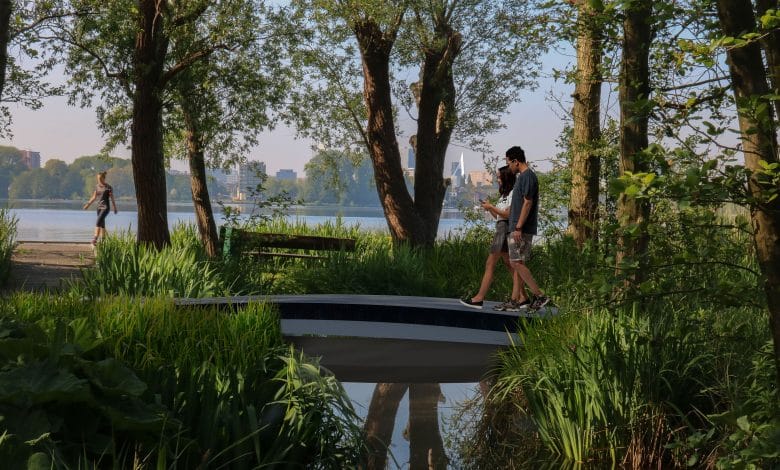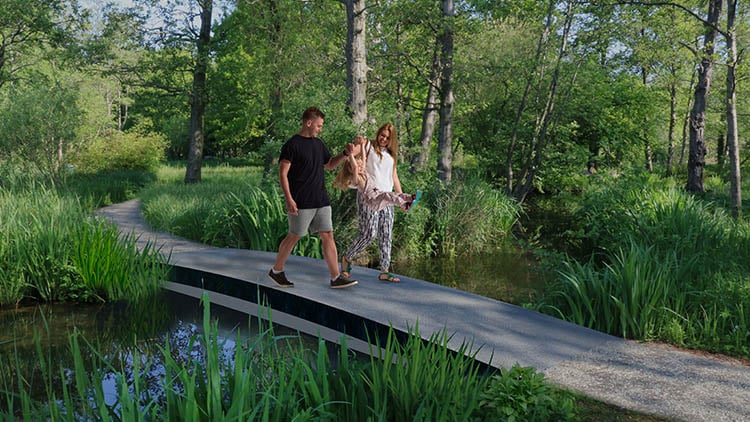The city of Rotterdam in the Netherlands is an example of the fusion of traditional and modern architecture, design and technology. Due to the destruction of most of the cities in World War II, Rotterdam had to be rebuilt, and an impressive and forward-looking approach has been adopted in the past few decades. This innovative spirit is reflected in the city’s latest project: the construction of a 3D printed composite pedestrian bridge.
The structure will become the world’s first lightweight 3D printed fiber-reinforced polymer (FRP) footbridge and will be installed in the Kralingse Bos Park in Rotterdam. The bridge was built by Royal HaskoningDHV, a collaboration between the scientific and materials company DSM and the city of Rotterdam.
Another important aspect of the 3D printed footbridge is that it will be built on a circular sustainable model. In other words, a composite bridge made from recyclable materials is part of the city’s sustainable development goals to reduce its carbon footprint and improve livability.
“The city of Rotterdam is proud to be a leader in the smart and circular use of composite bridges,” commented Mozafar Said, Asset Manager from the City of Rotterdam. “Together with Royal HaskoningDHV and DSM, we are continuing to push the frontiers of sustainability for bridges, using thermoplastics which will enable greater circularity. The 3D printed FRP footbridge as a circular composite aligns with our city’s ambitious sustainability targets to reduce carbon footprint and promote liveability and we are proud to be the first city to test, print and install it.”
The composite footbridge can provide a sustainable alternative for future bridge production in the city. Said added: “We see composite bridges as a sensible solution to replace old structures.” “Rotterdam has more than 1,000 bridges and we are always looking for breakthroughs to develop next-generation bridges that will be more sustainable And roundness, and reduce maintenance and life cycle costs.”
The initial prototype of the circular composite bridge was announced in 2019, and the upcoming structure will demonstrate the progress of the project. The bridge itself will be 3D printed with DSM fiber-reinforced thermoplastic called Arnite to meet the strength and sustainability requirements of the city.
When talking about the project, Patrick Duis, a senior application development expert in DSM additive manufacturing, said: “Printing a circular composite bridge minimizes wear and transitions to a more sustainable circular bridge. Now, with the new round composite materials of recyclable raw materials and the required usable properties, we can begin to raise the environmentally friendly design of infrastructure to a new level.”
The new structure will be built in accordance with the highest safety standards for FRP bridge design and will be supported by Rotterdam composite bridge infrastructure experts. It is also possible to include sensors in the finished product to create a digital twin of the pedestrian bridge. These sensors can predict and optimize maintenance to ensure the integrity and safety of the bridge, while also helping to extend its service life. The completed pedestrian bridge is expected to be put into use by the end of this year.
“Rotterdam and the Netherlands are ahead of the curve in innovation in infrastructure, particularly in the areas of sustainability and circularity,” concluded Maurice Kardas, Business Development Manager at Royal Haskoning DHV. “By introducing circular composites into their bridge infrastructure, Rotterdam proves once again to be a city ahead of the game. This is a step-change that signifies a collective effort to bring innovation from idea to realization and ushers in a new era of sustainable design and bridge functionality.”


